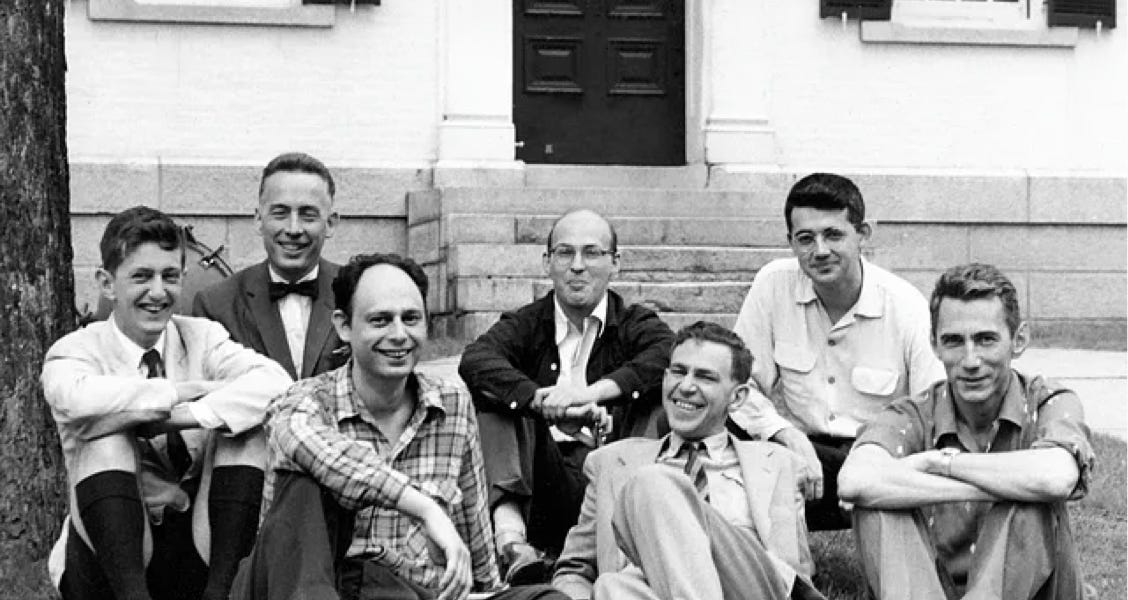The Birthplace of AI (1956)

🌈 Abstract
The article discusses the 1956 Dartmouth Summer Research Project on Artificial Intelligence, which is considered the founding moment for artificial intelligence as a field of research. It covers the motivation behind the project, the proposal, the attendees, and the outcomes.
🙋 Q&A
[01] The Birth of AI (1956)
1. What was the Dartmouth Summer Research Project on Artificial Intelligence?
- It was an academic workshop held in 1956 in Hanover, New Hampshire, which is sometimes considered the founding moment for artificial intelligence as a field of research.
- The conference gathered around 20 of the brightest minds in computer and cognitive science to work on the idea that "every aspect of learning or any other feature of intelligence can in principle be so precisely described that a machine can be made to simulate it."
2. Who were the key organizers and attendees of the conference?
- The key organizers were John McCarthy, Marvin Minsky, Claude Shannon, and Nathaniel Rochester.
- Notable attendees included future Nobel laureates John Nash and Herbert A. Simon, as well as Allen Newell, Oliver Selfridge, Julian Bigelow, and others.
3. What were some of the key outcomes and contributions from the conference?
- The term "artificial intelligence" was first coined by John McCarthy during the conference.
- Significant work was done on the Information Processing Language (IPL) and the Logic Theory Machine by Newell, Shaw, and Simon.
- Arthur Samuel coined the term "machine learning" in 1959 and created one of the world's first successful self-learning programs.
- Minsky, Newell, and Simon went on to win the Turing Award for their contributions to artificial intelligence and cognitive psychology.
[02] Motivation
1. What was the motivation behind organizing the Dartmouth Summer Research Project?
- Prior to the conference, McCarthy and Shannon had been co-editing a book on automata studies, but McCarthy was disappointed by the lack of emphasis on the possibilities of computers possessing intelligence beyond simple behaviors.
- McCarthy believed that if the key interested parties could be brought together to focus on the problem, significant progress could be made.
2. How did the key organizers come together to propose the project?
- McCarthy initially had Minsky in mind, as they had discussed AI before.
- McCarthy then learned that Shannon and Rochester were also interested in the topic, and the four of them collaborated to submit the proposal.
[03] The Proposal
1. What were the key points outlined in the proposal?
- The proposal was for a 2-month, 10-person study of artificial intelligence to be carried out at Dartmouth College in the summer of 1956.
- It outlined several aspects of the AI problem to be explored, including automatic computers, language use, neural networks, complexity theory, self-improvement, abstraction, and creativity.
2. What were the backgrounds and contributions of the proposal's signatories?
- Shannon was an established senior researcher known for his work on information theory and cryptography.
- McCarthy and Minsky were younger researchers who had worked together and were interested in theoretical computing and brain modeling.
- Rochester was a senior engineer at IBM who had worked on computing machinery and simulation of neural networks.
[04] Attendees
1. What were the common beliefs shared by the attendees?
- The attendees shared the belief that thinking is a form of computation that can be understood scientifically and replicated in digital computers.
2. What were some of the notable attendees and their contributions?
- John Nash and Herbert Simon were future Nobel laureates who attended the conference.
- Allen Newell and Herbert Simon collaborated on the Information Processing Language (IPL) and pioneering AI programs like the Logic Theorist and General Problem Solver.
- Oliver Selfridge, known as the "Father of Machine Perception", presented his work on pattern recognition and machine learning.
[05] Outcomes
1. What were the challenges in realizing the original vision of the conference?
- The intense and sustained exchange of ideas envisioned by McCarthy did not fully materialize, as attendees were stubborn about pursuing their own pre-existing ideas and did not stay for the full duration.
2. What were some of the key outcomes and lasting contributions from the conference?
- The term "artificial intelligence" was coined by John McCarthy during the conference.
- Significant work was done on the Information Processing Language and related AI programs by Newell, Shaw, and Simon.
- Arthur Samuel coined the term "machine learning" and created one of the first successful self-learning programs.
- Minsky, Newell, and Simon went on to win the Turing Award for their contributions to AI and cognitive psychology.
</output_format>